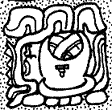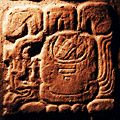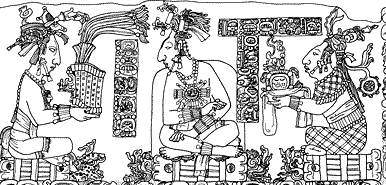|
Home - Tablet
image - Tablet image (large scale)
Palace Tablet: previous glyph - next glyph - Column QR |

|
Glyph Q16 tzi-?-hoy-ni-la -- Wald, 1999 Xoc -- Schele, 1988 |

Photo: Mark Van Stone zoom Drawing: Merle Greene Robertson | different lighting |
|
Simon Martin (personal communication 2002) points to the similarity of this glyph and the square-nosed beast and cross-band jar on a codex-style vase in Robicsek and Hales (1981:Table 13c).
In 1988, Linda Schele commented on this glyph and its context: "The final phrases in the main text record a 'house' event as the verb. From this context and others, I think that the house event is the dedication of the building in which the tablet was found, that the dedication took place over a three day period. The glyph following the yotot glyph [R15] may be the proper name of the person who conducted this rite, Xoc, a personage who must have been a high noble, but not a king. "The house dedication is followed immediately by another glyph and Kan-Xul's name. Evidence from the Yaxchilan Hieroglyphic Stairs 2 suggests strongly that the glyph before Kan-Xul's name is verbal, but surely Kan-Xul was dead on this date. He was captured and sacrificed at Tonina. Perhaps the event is one that was posthumous, but his interpretation is not supported by the Yaxchilan texts. I do not know how to interpret this strange reference to the dead Kan-Xul (Schele, 1988)." Schele subsequently (1993) revised her reading of the Palace Tablet and determined, in conjunction with Peter Mathews, that there was no individual named Xoc. Instead they referenced a character named Ux Yohun. (Also spelled Ox Yohun; see next glyph, R16 and glyph S4.) Schele commented: "The tail end of the Palace Tablet, a very long inscription on the north side of the Palace, I think, like the third tablet of the Temple of the Inscriptions, was purposely left blank in its final area to be carved and record the death of K'an-Hok'-Chitam II [also known as Kan-Xul II and K'inich Kan Joy Chitam II]. Instead of that, if that was the intention, it's not what we get, perhaps because of the untimely fate of K'an-Hok'-Chitam II. "Recorded, then, is different information and up in the scene of the Palace Tablet are two secondary texts [S1-S5 and T1-X1]. We have talked about another individual ... who we identified by this glyph (U5) with the name Xoc and thought that he might be some extra ruler. This is because, initially, 20 years ago there was still a big gap here. We didn't have the capture monument at Tonina and so we had a lot of events early in the life of life of K'an-Hok'-Chitam II, but not much else. Floyd [Lounsbury] was the one who identified Xoc, and we thought at the time that it solved a major problem in the sequence. "It now turns out that this was not even read Xok and it is not even a reference to an individual in this case. What is happening is that these passages up here [S1-S5 and T1-X1] talk about a subsidiary figure who seems to have taken over at Palenque to keep things going and perhaps was trying to get K'an-Hok'-Chitam II back or perhaps until the dynastic situation could be sorted out and a new person could become king. "My own feeling is that the keeping alive of the captives, royal captives especially, may have enhanced the home site. If you think about what happened to Moctezuma and Cortez after he was effectively captured by Cortez, the Aztecs for a short period were paralyzed. They didn't quite know how to act because their emperor, from whom they took all of their orders, wasn't able to give the orders. There may have been a similar situation at Palenque. |

| "Anyway, in this caption here [S1-S5] we get a reference to another individual. K'an-Hok'-Chitam II is not mentioned at all. Instead we get on the day 1 Ahaw (S1) 3 Wayeb (S2) he was born (S3) and this has to be the name of the extra individual (S4). The date is 9.10.17.6.0. When Floyd looked at this he pointed out that this birth date is just 6 years after K'an-Hok'-Chitam II's own birthday and so we thought for a long time, (and it's still a good possibility) that this was yet another brother 6 years younger than K'an-Hok'-Chitam II who took over after K'an-Hok'-Chitam II's - we thought then - natural death. His name is Ux Yohun (Linda Schele and Peter Mathews, 1993)." |
| Karen Bassie, together with Kathryn Josserand and Nicholas Hopkins, has suggested that Ox Yo Hun is the name of the object that is being handed to the central figure in the Palace Tablet scene; it names the drum major headdress. |

|
Bassie explains: "The caption text does not state who is giving or who is receiving the headdress but the main text begins with the birth of Kan Xul and gives his parentage statement. He is the protagonist of the narrative and he should, therefore, be the central actor with the flanking actors being Pacal and Lady Ahpo Hel.
"The only 8 Ahau 18 Xul date on which all three actors were alive was 9.11.1.13.0 when Kan Xul was 9 years old (9.14.0 to be exact). So I think the Palace Tablet scene is a preaccession event in which the focus is Kan Xul receiving the drum major headdress, and this was followed by his mother giving him the tok pacal icon. (The left side of the Temple of the Sun tablet shows Chan Bahlum holding his tok pacal.) The climax of the main text appears to be about dedicating a house/temple for the drum major headdress. In The Mouth of the Dark Cave, I argued that the drum major headdress and tok pacal were specifically related to GIII and the TI text appears to state that the jester god helmet headdress belongs to GIII (Karen Bassie, email to Alfonso Morales, 1999)." Marc Zender adds this perspective: "There probably never was an individual named Ox-Yohun. This name is actually Ux-Hu'n, and appears elsewhere in the script as a reference to the Jester God and thrice on the Palace Tablet in what it almost certainly a reference to the Jester-God Pendant on the Palenque crown. In the main body of the text, the final sentence indicates that 'fire-entered into the accession-house named 'Ux-K'in Ja'at, the house of the Jester-God which is the property of K'inich-K'an-Hoy-Chitam'. "This might be a circular way of referring to the king's crown still sitting in the throne room even though he was in jail in Tonina. Above, the texts betwixt what are clearly the images of K'an-Hoy-Chitam and his parents, is a text referring to the birth (ie. creation) of the jester-god jewel and its presentation to the king. Thus Ux-Hu'n was surely neither ruler nor regent (nor even a human) twixt the reigns of K'inich K'an-Hoy-Chitam II and K'inich Ahkal-Mo'-Nahb' III (Marc Zender, email to Joel Skidmore, 1999)." |